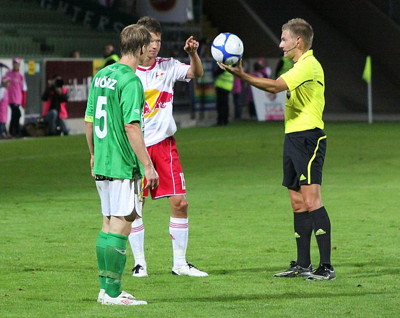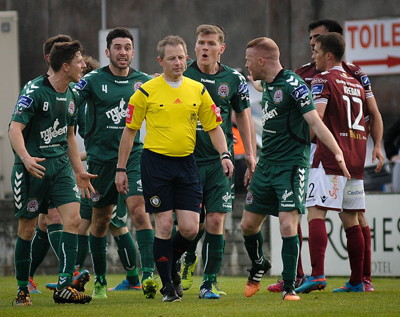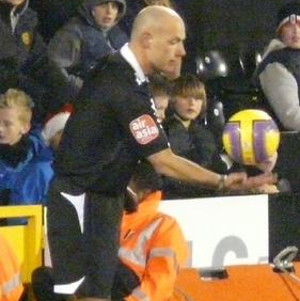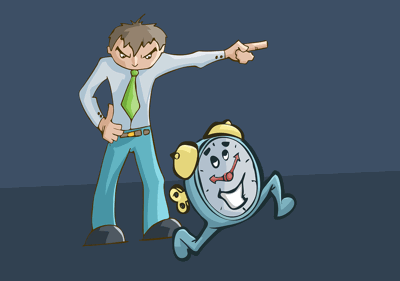
In the modern game, there are few things as frustrating as seeing the team you support kicking the ball into touch because a member of the opposition has gone down with an injury.
This is even more frustrating when you’re convinced that they’re not really injured and are actually just faking it in order to waste time, with your team’s player seemingly buying what they’re selling and giving them what they want.
Sometimes the referee will blow the whistle, especially if the player that has gone down seems to be indicating that they’ve got a head wound.
When this happens, it’s not uncommon for the team that had the injured player to kick the ball back to their opponents, but occasionally a bounce-ball will be required (also called drop-ball, dropped-ball or bounce-up). That used to involved two players competing to win the ball, but even that practise has been stopped nowadays.
Sportsmanship Or Tradition?
 For those that have watched football for some time, the sight of a team kicking the ball back to the opposition in the wake of an injury is common practice. Indeed, at most football grounds up and down the country, it’s not unusual for supporters to shout abuse at their own players for kicking the ball out of play in the first place, especially if the crowd is of the belief that the ‘injured’ player was feigning their injury in the first place.
For those that have watched football for some time, the sight of a team kicking the ball back to the opposition in the wake of an injury is common practice. Indeed, at most football grounds up and down the country, it’s not unusual for supporters to shout abuse at their own players for kicking the ball out of play in the first place, especially if the crowd is of the belief that the ‘injured’ player was feigning their injury in the first place.
The question many will ask is whether teams do this because it is a tradition that has always been done or because it is seen as sportsmanlike. The answer is somewhere in the middle, with teams having always been ‘gentlemen’ in the past and therefore owing to do the thing that displays the most class. Of course, back then the player that was injured will not have been faking it because that would not have been classy.
It is a traditional part of football that a team with an injured player will kick the ball out of play so that their player can receive treatment for their injury, with the opposition side then giving them the ball back because that’s the ‘right thing to do’. After all, the team with the injured player wouldn’t have put the ball into touch if their player hadn’t been injured. The same is true if the opposition side has a player with an injury, the team in possession of the ball will put it out of play and then be given it back.
None of this is in the rules of the game. There is nothing that says one team must return the ball to the other, but it is a courtesy to do so. It’s unusual for a team to refuse to do it, given that the opposition could then choose to do the same thing if the original team got an injury later in the match. If the attacking team sees that the defensive side has an injury but are unconvinced about its authenticity, it is a grey area and the attacking team will sometimes continue to attack.
When It Goes Wrong

Things don’t always work out as they’re supposed to, of course. In 2015, for example, Bury put the ball out of play in order to allow a Doncaster player to receive treatment. Afterwards, one Doncaster player took the throw and another kicked it back to the Bury goalkeeper, only for the ball to go over his head and into the back of the net. After much discussion between players, officials and the benches, sportsmanship took over.
Doncaster kicked the match off again and one of their players strode the length of the pitch and put the ball into the back of the net, to boos from opposition supporters. It was the only action of the match, which finished 1-1 and once again proved the confusion that can reign over such incidents. Bury were never intending to score, but once they did they felt that they had a duty to allow Doncaster to equalise without challenge.
Perhaps no match in football history has demonstrated the ‘moral’ question of putting the ball out of play quite like the match between Leeds United and Aston Villa when both clubs were in the Championship during the 2018-2019 season and were each chasing promotion. Things all started when Villa’s Jonathan Kodjia went down with an injury after a tackle from a Leeds player, but the referee didn’t give a free-kick.
Leeds had possession and looked as if they were going to put the ball out of play, copying what Aston Villa had done earlier in the match when the Leeds player Adam Forshaw had gone down injured. The Leeds player with the ball slowed down and kicked it gently up the pitch as Villa’s players stopped, only for one of his teammates to pick up the ball, stride forward and put it into the back of the net.
Pandemonium then broke out, with Anwar El Ghazi getting sent off for violent play despite not actually touching Patrick Bamford in the ensuing melee. Leeds’ manager Marcelo Bielsa then instructed his team to allow Aston Villa to score a goal uncontested, which one Leeds player, Pontus Jansson, disagreed with and tried to tackle them to win the ball back. As with the Bury versus Doncaster game, the match finished 1-1.
The Bounce Up or Drop Ball

Football supporters of a certain vintage will remember the days when a match would call for the ball to re-enter play at the hands of the referee, who would ask a player from each side to contest a ‘bounce ball’. Oftentimes the two players involved would be desperate to win the ball from each other, resulting in proper clashes and tackles as the match got back underway, with whichever team won the ball regaining possession.
Over the years, this form of re-starting a match began to be watered down more and more and one team would invariably kick the ball back to the other team. Which team would do the kicking and which would do the receiving would depend entirely on what had happened in the build up to the referee stopping the match, but the main thing was that they would figure it out between themselves in consultation with the official.
That method of re-starting matches is one that is actually written into the rules of the game, which state the following:
The ball is dropped for the defending team goalkeeper in their penalty area if, when play was stopped:
- The ball was in the penalty area or
- The last touch of the ball was in the penalty area
- In all other cases, the referee drops the ball for one player of the team that last touched the ball at the position where it last touched a player, an outside agent or, as outlined in Law 9.1, a match official
- All other players (of both teams) must remain at least 4 m (4.5 yds) from the ball until it is in play
- The ball is in play when it touches the ground.
Any number of players may contest a dropped ball (including the goalkeepers); the referee cannot decide who may contest a dropped ball or its outcome.
The rules also dictate what happens in the event of a goal being scored from a dropped ball. If the team that wins the ball scores straight from the drop against the opposition without the ball having touched two players, a goal kick is awarded to the opposition. If the team receiving the ball essentially scores an own goal without the ball touching two players then the opposition gets a goal-kick.
Is It All About Time-Wasting?
 It’s probably fair to say that, in the vast majority of cases, both teams know when a player has gone down with an injury whether they are actually injured or not. That’s not a given 100% of the time, of course, but the nature of the tackle or fall combined with the noise made by the player will dictate whether or not their injury needs to be taken seriously. Consequently, players will judge for themselves whether to put the ball out of play.
It’s probably fair to say that, in the vast majority of cases, both teams know when a player has gone down with an injury whether they are actually injured or not. That’s not a given 100% of the time, of course, but the nature of the tackle or fall combined with the noise made by the player will dictate whether or not their injury needs to be taken seriously. Consequently, players will judge for themselves whether to put the ball out of play.
It has become common for referees to end the play if there is even the slightest hint of a head injury, given how serious concussions are in the modern game. Other than that, however, it is is not necessarily the job of the referee to stop the game for an injury, meaning that the players have to do it for themselves. The years when footballers were gentlemen making decisions that were sportsmanlike are, sadly gone.
Instead, players will now go down holding their face when an opposition player’s arm has gone nowhere near it, either in the hope of getting them sent off or conning the referee into thinking that they’ve got a head injury. What was once a nice tradition that saw opposition sides put the ball out of play because a player might need treatment has now become filled with doubt, suspicion and misdirection from all involved.
It’s part of the reason why supporters get so annoyed when they see their team put the ball into touch, because they don’t believe that the player receiving treatment is actually injured. There’s a rule of thumb that teams should kick the ball out, but often they won’t because they just don’t believe that the player needs treatment and think that it’s just about them trying to waste time.
When Liverpool played Manchester United at Old Trafford in the 2020-2021 season, Bruno Fernandes went down feigning injury as a United attack broke down and the Reds began to break. Because the players didn’t believe that Fernandes was injured, they refused to put the ball into touch and Paul Pogba petulantly kicked out at Andy Robertson, resulting in Liverpool getting a free-kick from which they scored.
Obviously there’s no love lost between those two teams at the best of times, but that was an example of one side deciding that the other team didn’t actually deserve possession of the ball and therefore continuing with their attack. There was nothing the referee could, or should, do to prevent it happening, with United players barely protesting after seeing Fernandes feign injury time and again in the past.
Liverpool, of course, have been in similar situations themselves in the past. Their infamous Uruguayan striker Luis Suarez once went down in a heap after being challenging, curling up into a ball as if he’d suffered a career-ending injury. When Liverpool regained possession, Suarez was up on his feet and joining the attack in no time, keen to be involved in the possibility of scoring a goal.
Players in the modern game try to play the referee whenever they can, with all clubs having those on their side that try to use such tricks. Supporters hate it when they’re on the receiving end of that sort of play and love it when it’s their players getting up to no good, such is the extent to which the sport is filled with hypocrisy. If they can pretend to be injured and waste time and no one will stop them, why wouldn’t they?
Referees Should Add More Time
 Part of the problem is that players are allowed to get away with their antics. There’s no way for a referee to prove that a player isn’t actually injured, of course, but there is plenty that they could do to dissuade players from trying to pull a fast one. How many times, for example, have we seen a player get injured off the pitch before rolling back onto it in order to stop the match from being able to carry on until they’ve had treatment?
Part of the problem is that players are allowed to get away with their antics. There’s no way for a referee to prove that a player isn’t actually injured, of course, but there is plenty that they could do to dissuade players from trying to pull a fast one. How many times, for example, have we seen a player get injured off the pitch before rolling back onto it in order to stop the match from being able to carry on until they’ve had treatment?
The issue isn’t so much that they do it, given every team on the planet will get up to such trickery, but rather that the officials then don’t add a sufficient amount of time on at the end of the game. If a player goes down injured and the opposition puts the ball out of play so that they can receive treatment, the game could be suspended for five minutes or more. When the referee adds time on at the end of the match, however, it is invariable far less than the match was stopped for.
The only way to dissuade players from feigning an injury in order to waste time in a match is to make sure that the correct amount of time is added to play when the half reaches its conclusion. It is the main area of refereeing in which even the best officials fail in their duty, meaning that teams will forever be forced to debate whether to actually put the ball into touch or not. Get the timings right and referees can take that decision out of their hands.
